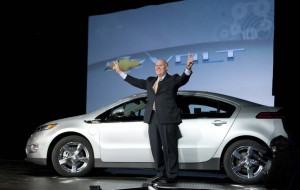
EVs like the Chevrolet Volt, pictured with GM CEO Dan Akerson, have eased buyers' concerns about the range of EVs. However, they're still too expensive.
All of the efforts by manufacturers to make electric vehicles more popular seem to be working; however, there is one issue that they haven’t resolved that may be keeping EV sales from taking off: price.
EVs and all their variants – hybrids, plug-in hybrids, etc. – are still too expensive, in spite of potential savings on fuel.
Navigant Research, a consulting firm located in Boulder, Colo., surveyed nearly 1,100 people to determine how they feel about new vehicle prices and electric vehicles. The company found that 71% want their next vehicle to cost less than $25,000, while 41% are looking below $20K.
It also discovered that 67% of those surveyed had a favorable opinion on hybrids while 61% thought positively of EVs. In short, well over half the market would consider buying an EV or hybrid, but cannot because the price is too high.
However, the tide could be turning, according to Navigant. Battery packs, which can account for as much as half of PEV costs, are expected to decrease between now and 2020. HEVs and PHEVs are anticipated to see a 10% and 26% decline, while BEVs will likely remain flat, but see improvements in vehicle range and performance during that period.
(Honda Accord named Green Car of the Year. For more, Click Here.)
When combined with gas and diesel prices that are expected to rise 7.2% and 8.3% respectively during the same time period, Navigant believes the buyers are coming.
Navigant Research forecasts global CAGRs of 11.5% for hybrids, 31.9% for plug-in hybrids and 31.5% for battery-electrics. Asia Pacific and North America are expected to be the largest markets for hybrids, with Japan and the United States being the largest singular markets: 1.1 million and 1 million HEV sales in 2020, respectively.
(Click Here to see how Tesla is dealing with the NHTSA investigation.)
North America is the only market anticipated to have significantly higher sales of plug-ins than battery-electrics (a 1.5:1 sales ratio); Western Europe, Asia Pacific, and Latin America will be almost evenly split between the drivetrains. Asia Pacific is projected to be the largest market for plug-in electric vehicles (PEVs), with 1.6 million PHEV and battery-electric sales combined in 2020.

A survey of 1,100 people hardly serves as an accurate barometer on any given subject. I’d bet my money that the lack of enthusiasm for EVs is a lot more than cost and more likely the cars themselves and the lack of range also which makes them totally impractical for most commuters except in the city.
Actually, Jorge, if I recall my stat classes at university, a survey of 1,100 people — if conducted properly — should yield an accuracy rate of +/- about 3% or so. Yes, I recall Dewey v Truman, but while there are many ways a survey can be flawed, they generally get pretty darn close. Conversely, one has to be cautious about the inherent biases and inaccuracies of using anecdotal and unscientific observational “data” to form a conclusion. We seem to have an epidemic of confusion between facts and opinions. While surveys cannot be “fact” until confirmed by results, a well-done research project is a lot closer to the truth side of the equation.
Paul A. Eisenstein
Publisher, TheDetroitBureau.com
I don’t believe for a minute that a survey of 1,100 people accurately represents the views of tens of millions of consumers regarding EVs.
As we know from many instances in recent years not only does the government lie constantly on financial statistics such as unemployment, economic growth, etc. only to be proven as lies later, the same is typical these days with surveys and even many “faked” research projects with an agenda – usually financially motivated.
Research projects paid for by those with a vested interest seem to routinely come up with the results the financing partner desires. This is called searching for the lucrative outcome, and is not proper science or research.
I think what the survey shows is that EV manufacturers have done well in terms of improving the range of their vehicles with options like hybrids, but still face a major challenge when it comes to pricing. A really good EV is still only an option for buyers with the biggest of wallets. Until that changes, the vehicles cannot be considered “successes.” In other words: keep working at it gang.